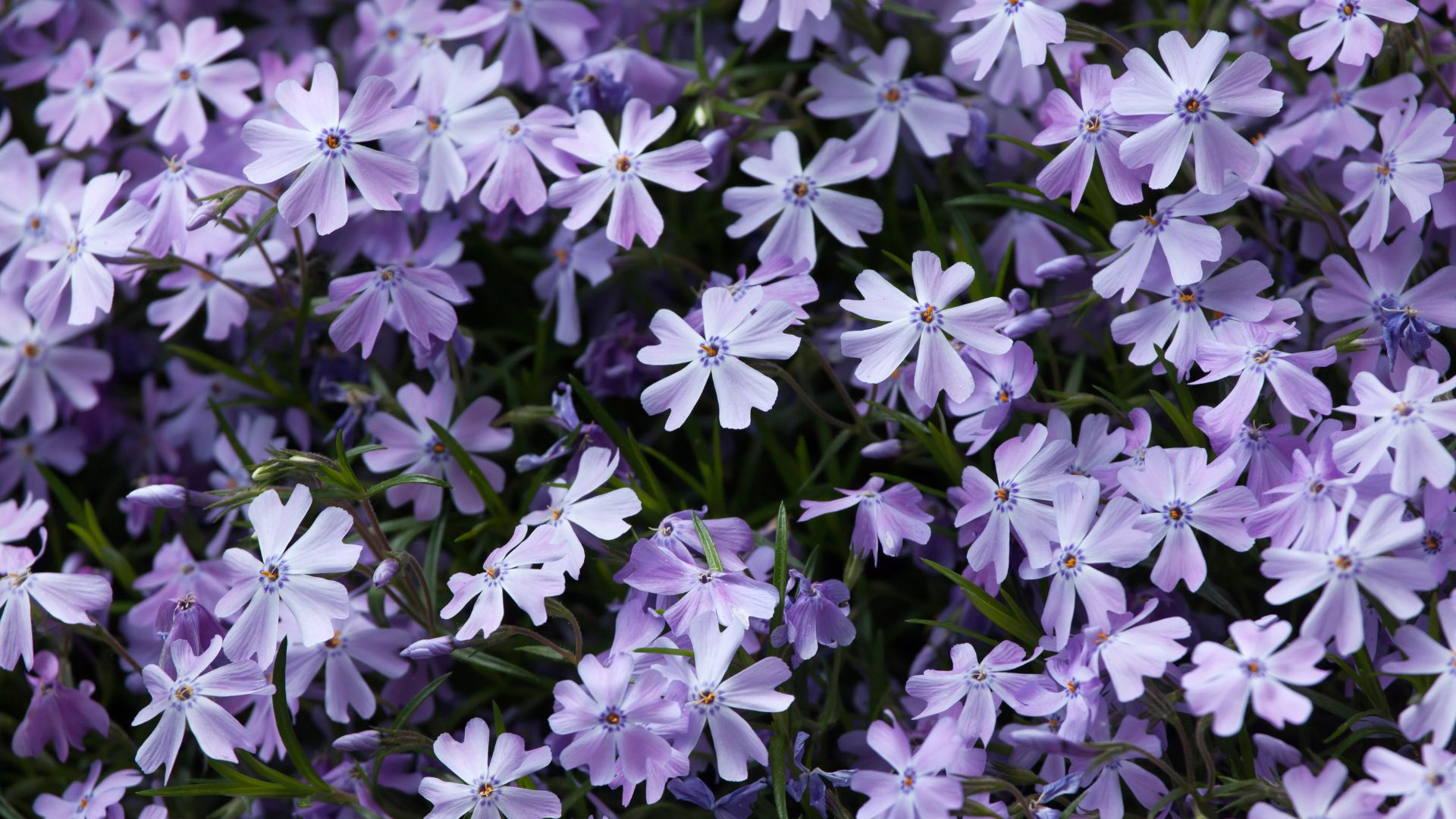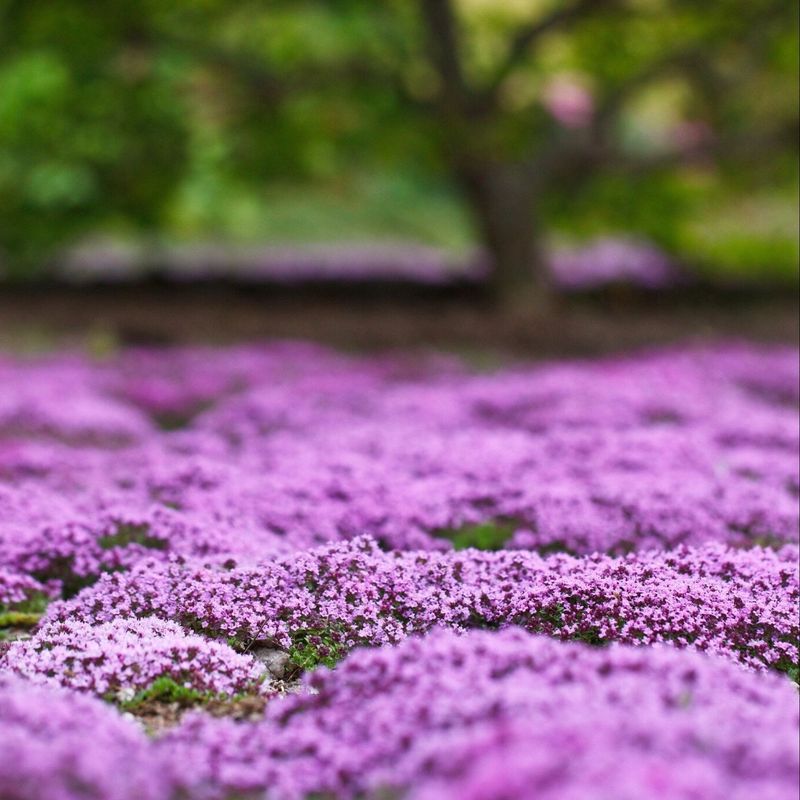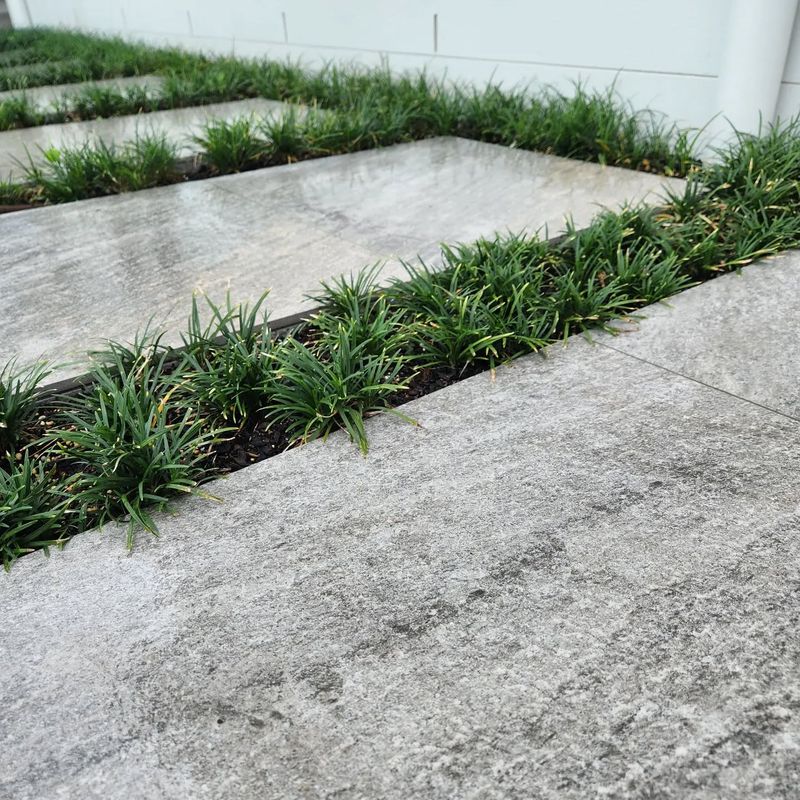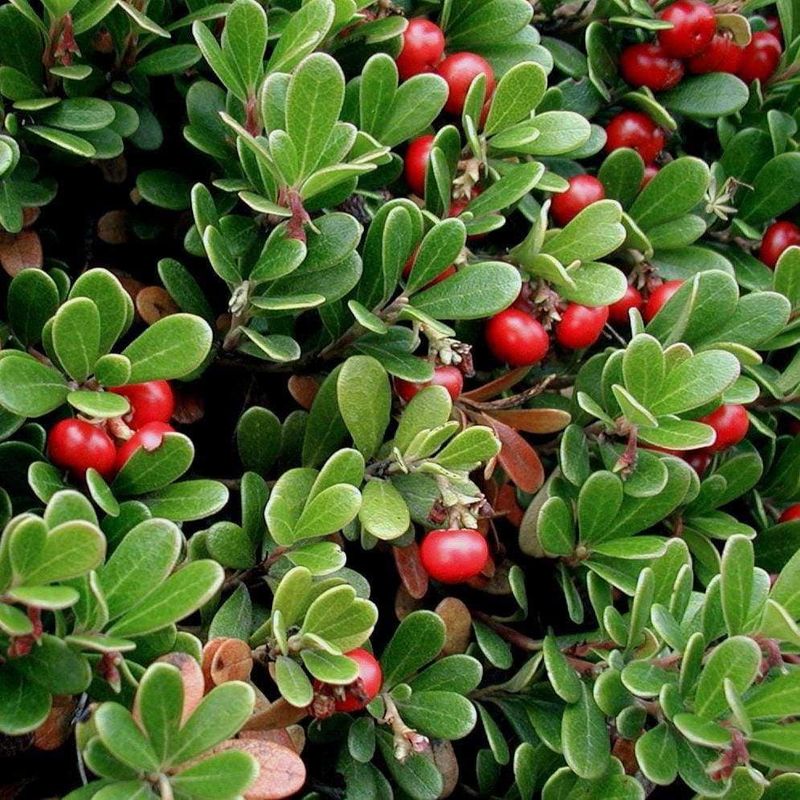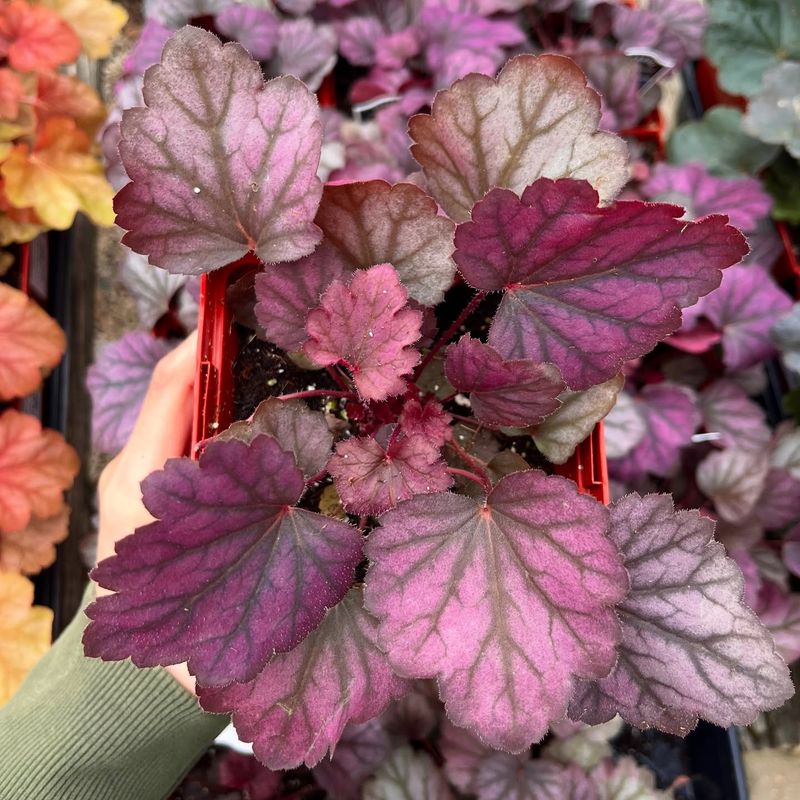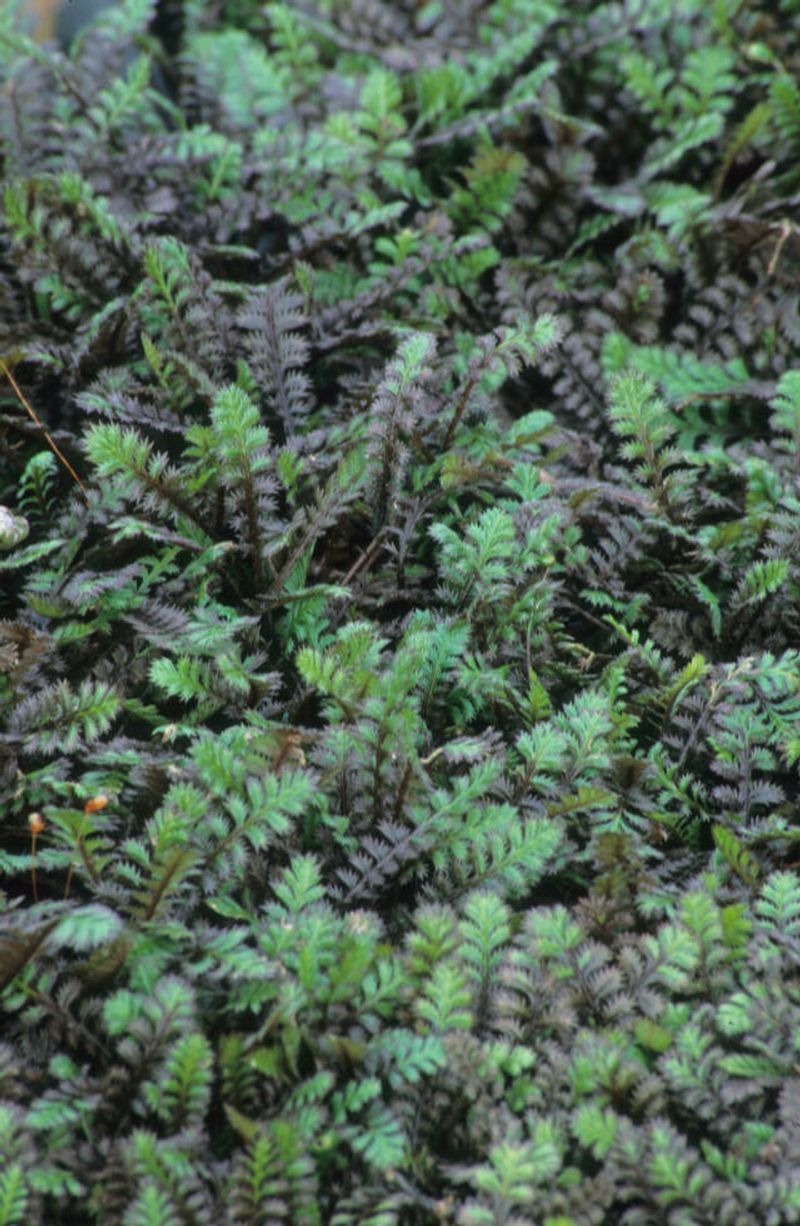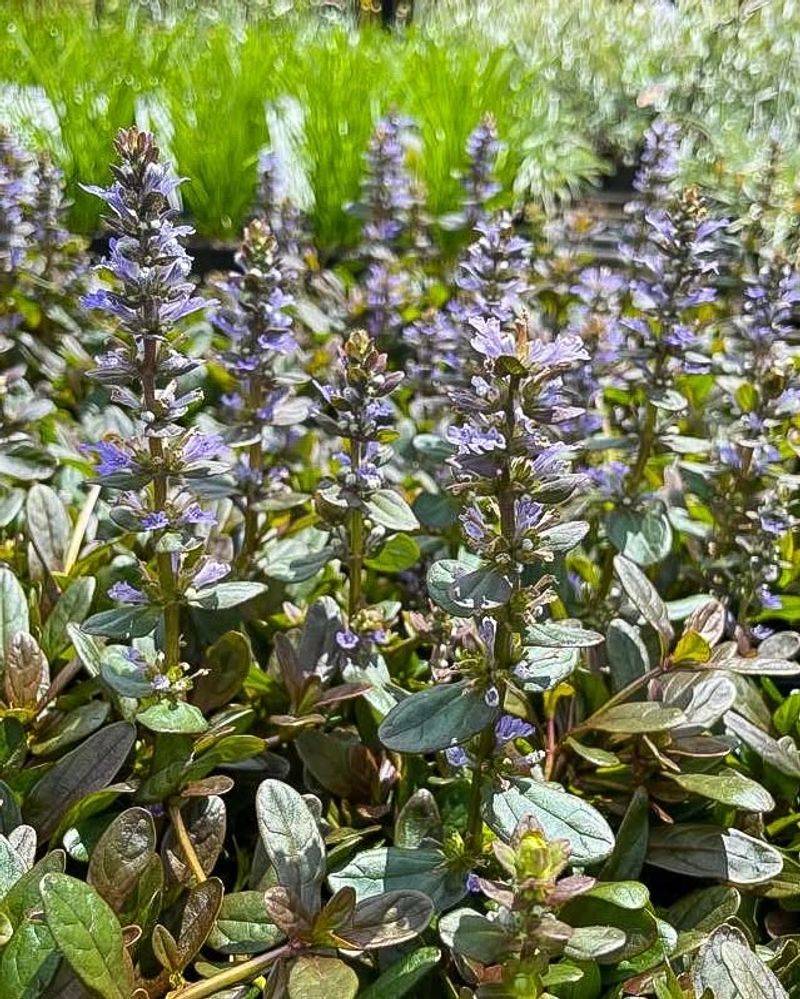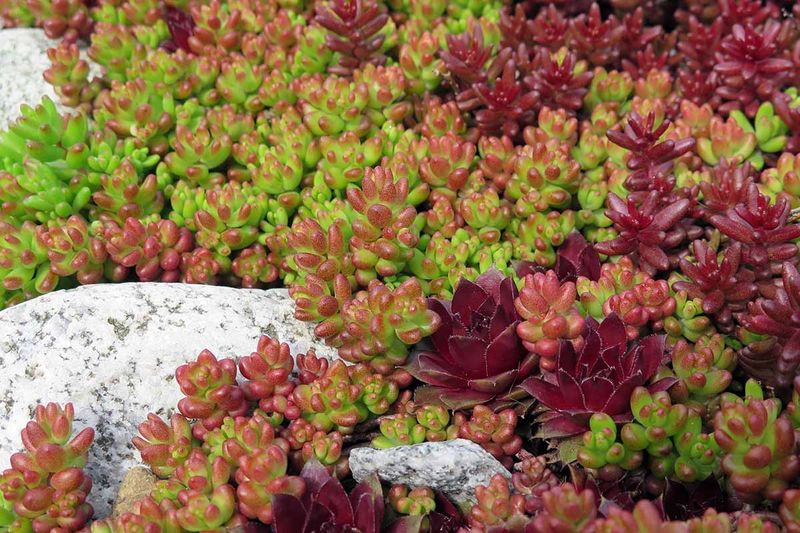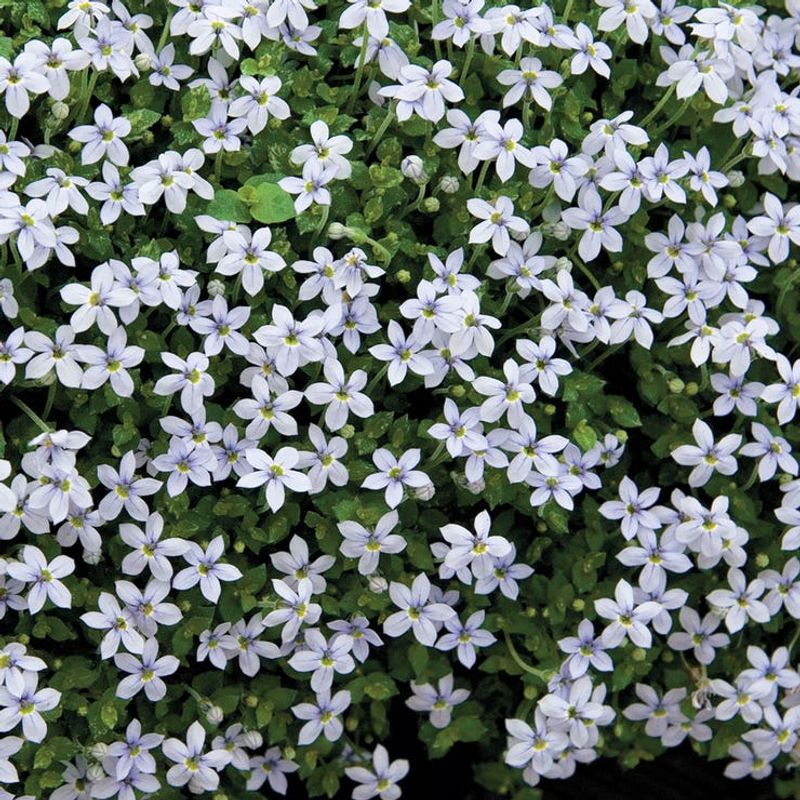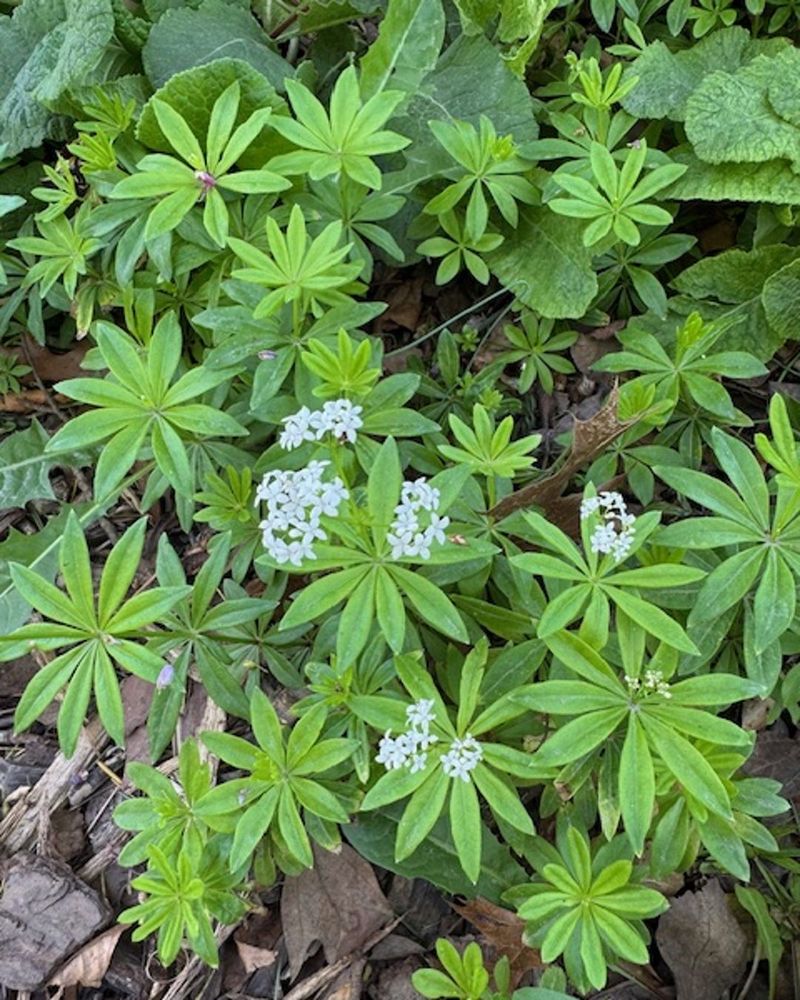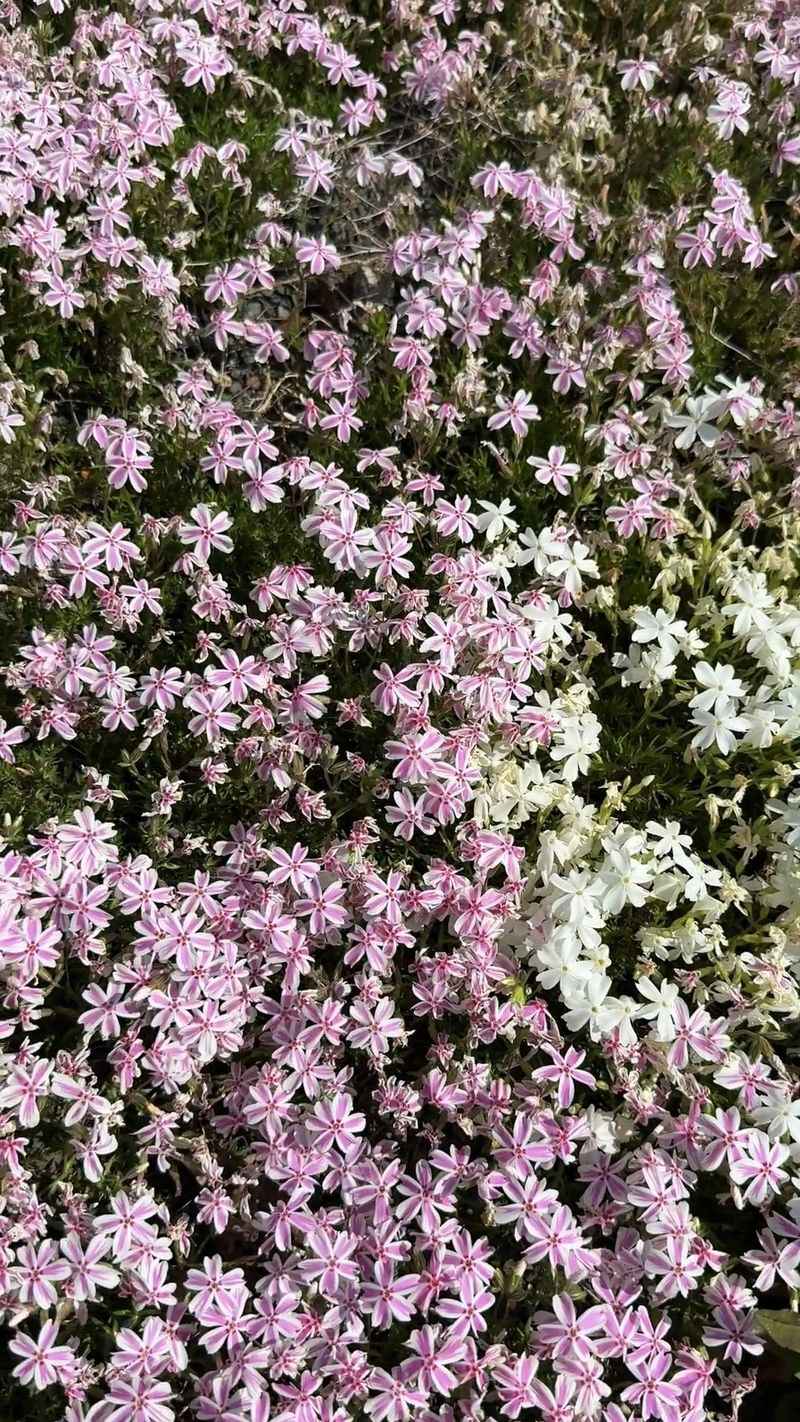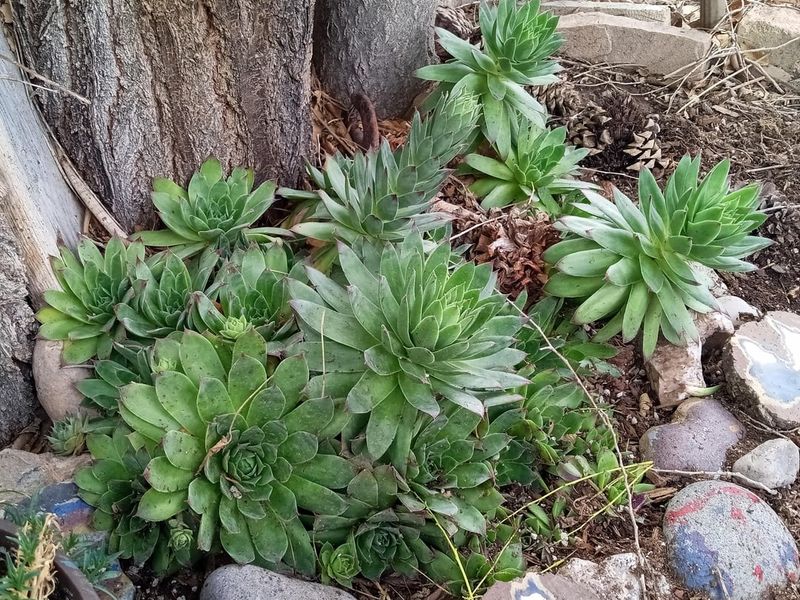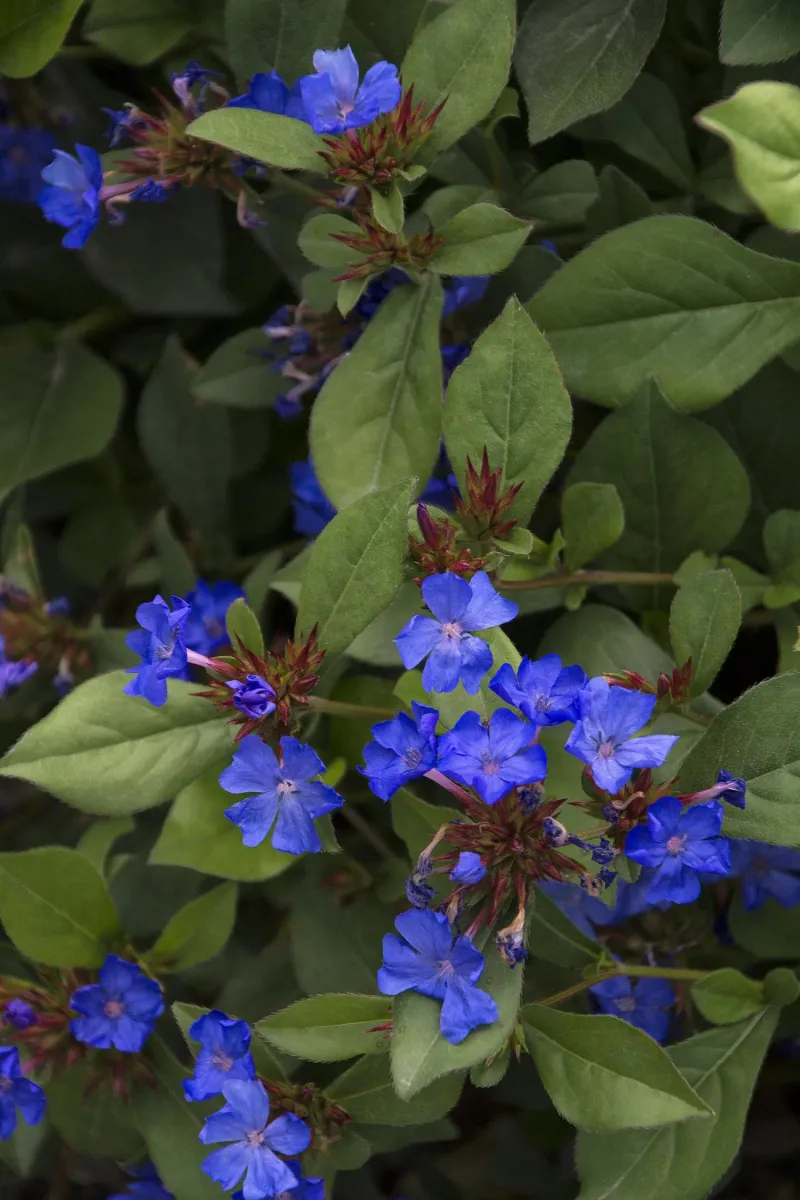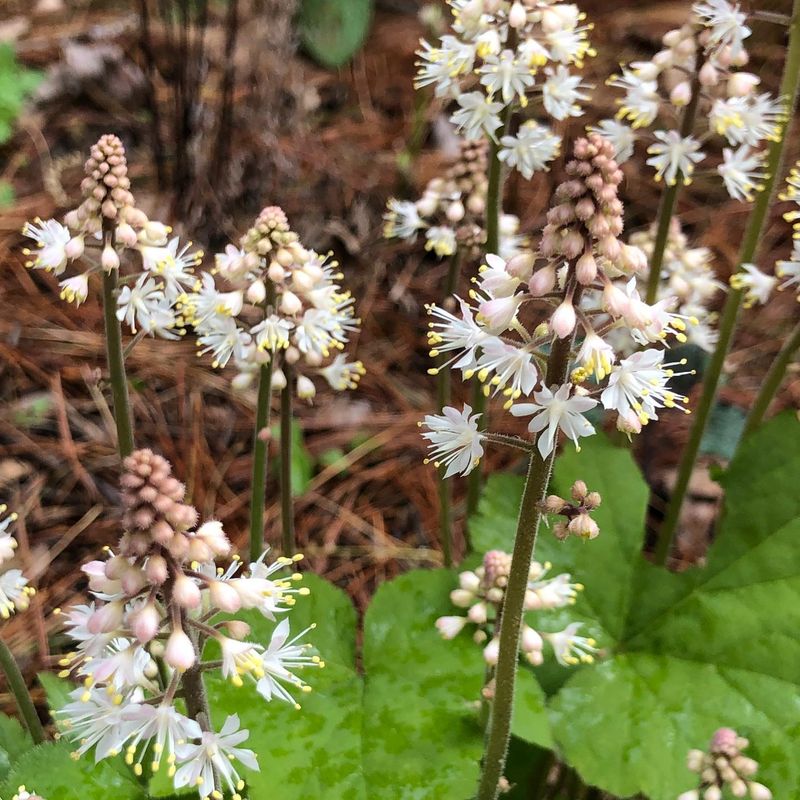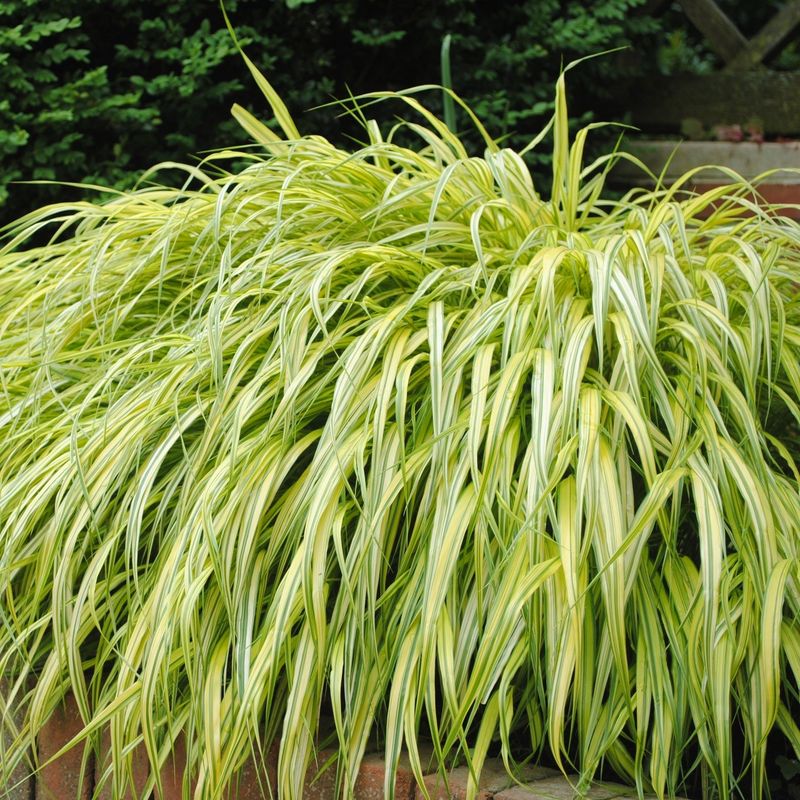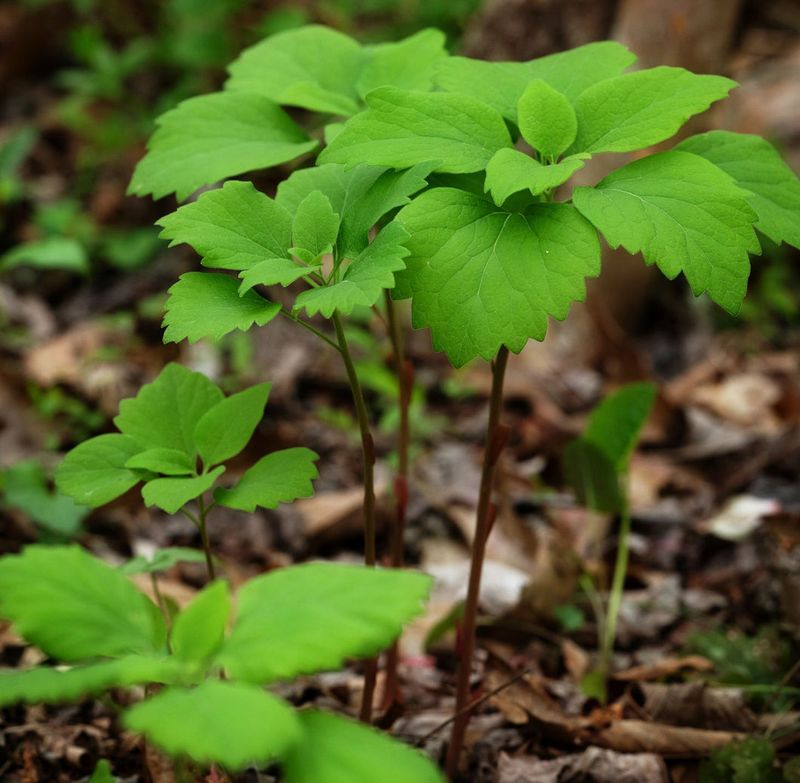Groundcovers can really help bring those dull, tricky parts of the yard to life. I’ve had plenty of moments where I planted something that looked great at first—only to watch it spread like crazy and take over everything else.
What I’ve learned is that the best groundcovers are the ones that know when to stop. They fill in bare spots, add some color, and behave themselves without turning into a full-time job.
These 15 easygoing plants have been total game-changers in my garden. They look great, play nice with others, and don’t cause a bunch of trouble down the line.
1. Creeping Thyme
Low-growing and wonderfully aromatic, creeping thyme releases a delightful scent when stepped on. The tiny leaves form a dense mat that stays put where you plant it, with pretty purple flowers that attract butterflies and bees.
Growing only 2-3 inches tall, it’s perfect between stepping stones or in rock gardens. I’ve had a patch by my garden path for years without it invading nearby areas.
Hardy in zones 4-9, this groundcover tolerates drought once established and requires minimal maintenance. Just give it well-draining soil and full sun for best flowering results.
2. Dwarf Mondo Grass
Unlike its more aggressive cousin, dwarf mondo grass creates elegant, tufted mounds that maintain their boundaries beautifully. The grass-like foliage grows in neat clumps reaching just 2-4 inches tall, with a slow-spreading habit.
Shade tolerance makes this plant exceptional for areas under trees where other groundcovers struggle. My shaded front yard border has contained the same dwarf mondo for five years without needing division.
Small purple flowers appear in summer, followed by black berries that add visual interest. The evergreen nature ensures year-round structure in zones 7-11.
3. Kinnikinnick
Native to North America, kinnikinnick (bearberry) combines rugged durability with polite growth habits. Small, glossy leaves create a carpet-like effect that turns bronzy in winter, adding seasonal interest.
Tiny pink bell-shaped flowers appear in spring, followed by bright red berries that persist through winter. Birds love them! The plant spreads gradually through underground stems but never becomes invasive in my experience.
Thriving in poor, sandy soils where other plants fail, this groundcover handles drought and cold down to zone 2. For a native plant option that stays put, kinnikinnick has been one of my most reliable choices.
4. Coral Bells
Forming neat mounds of colorful foliage, coral bells (Heuchera) offer stunning leaf colors ranging from purple to caramel, silver, and lime green. The clump-forming habit prevents them from spreading aggressively, making them perfect for borders.
Delicate flower stalks rise above the foliage in summer, attracting hummingbirds while adding vertical interest. After growing several varieties in my front border, I’ve found they stay exactly where planted year after year.
Preferring partial shade in hot climates, these plants perform beautifully in morning sun and afternoon shade. Most varieties are hardy in zones 4-9 and maintain their color throughout the growing season.
5. Brass Buttons
Resembling tiny ferns, brass buttons (Leptinella) create a dense carpet of bronze-green foliage that grows just 1-2 inches tall. The finely-textured leaves look almost metallic in certain lights, hence the common name.
Yellow button-like flowers appear in summer, contrasting nicely with the dark foliage. Spreading happens primarily through surface runners that are easy to control—simply trim back any areas that venture too far.
Hardy in zones 5-10, brass buttons tolerate light foot traffic and moderate drought once established. My patch between flagstones has maintained its boundaries for years with minimal intervention, making it a favorite for pathways.
6. Ajuga
Spikes of brilliant blue flowers rise above glossy, colorful foliage in spring, making ajuga (bugleweed) a standout performer in shade gardens. Unlike some aggressive varieties, newer cultivars like ‘Chocolate Chip’ spread slowly and stay manageable.
Semi-evergreen leaves come in shades of deep green, bronze, and purple, providing multi-season interest. The plant forms a dense mat that effectively suppresses weeds without overwhelming neighboring plants.
Performing best in zones 3-9, ajuga tolerates a range of soil conditions including clay. Having grown it along my woodland garden edge for years, I’ve found it fills spaces nicely without the invasive tendencies of mint family relatives.
7. Miniature Stonecrop
Succulent leaves arranged in tiny rosettes give miniature stonecrop (Sedum) a jewel-like appearance in the garden. Unlike larger sedum varieties, these diminutive types form tight mats that expand slowly, perfect for rock gardens and containers.
Star-shaped flowers in yellow, pink, or white appear in summer, attracting pollinators. The drought tolerance is remarkable—I’ve forgotten to water my stonecrop for weeks during summer heat with no ill effects.
Most varieties are hardy to zone 4 and thrive in poor, rocky soil where few other plants grow. Their shallow root systems make them easy to remove if they venture where unwanted, but I’ve rarely needed to control their spread.
8. Blue Star Creeper
Tiny blue star-shaped flowers float above a carpet of fine green foliage, creating a magical effect from spring through summer. Blue star creeper (Isotoma) forms a dense mat only 1-2 inches tall that fills spaces between stepping stones beautifully.
Growth happens at a moderate pace that’s easy to manage, unlike invasive creepers that take over gardens. The plant tolerates light foot traffic, making it ideal for pathways or between pavers where grass won’t grow.
Hardy in zones 5-9, blue star creeper prefers consistently moist soil but handles brief dry spells once established. After planting it in my courtyard three years ago, it’s maintained perfect proportions without becoming a nuisance.
9. Sweet Woodruff
Whorls of bright green leaves topped with delicate white flowers in spring give sweet woodruff a woodland fairy-tale quality. The foliage has a sweet vanilla scent when dried, traditionally used in potpourri and May wine.
Growing 6-8 inches tall, this groundcover spreads through shallow roots at a manageable pace in zones 4-8. Unlike mint family members, it maintains reasonable boundaries and won’t take over the garden. Shade tolerance makes sweet woodruff perfect for difficult spots under trees.
My patch under a large maple has filled in nicely over several years without becoming problematic, even with minimal attention and just natural rainfall.
10. Creeping Phlox
Carpets of vibrant spring color make creeping phlox a favorite for sunny spots in the garden. Needle-like evergreen foliage creates a dense mat that cascades beautifully over walls and slopes. Flowers in pink, purple, blue, and white completely cover the plants for several weeks in spring.
Growth happens primarily through above-ground stems that are easy to trim if they venture too far—a task I’ve rarely needed to perform in my front garden.
Hardy in zones 3-9, this North American native thrives in well-drained soil and full sun. After the spectacular spring show, the tidy evergreen foliage continues providing erosion control and weed suppression year-round.
11. Hens And Chicks
Rosettes of fleshy leaves in fascinating geometric patterns make hens and chicks (Sempervivum) both architectural and charming in the garden. The mother plants (hens) produce small offsets (chicks) that cluster around the base without spreading aggressively.
Available in greens, purples, reds, and golds, these succulents add year-round interest to rock gardens and containers. Mature plants occasionally produce tall flower stalks, though the rosette dies after flowering (but leaves plenty of offspring behind).
Extremely drought-tolerant and hardy to zone 3, hens and chicks thrive in poor, rocky soil with full sun. My collection along a hot, dry garden wall has remained perfectly behaved for years with zero maintenance.
12. Dwarf Plumbago
Sky-blue flowers appear throughout summer and fall above mounding foliage that turns brilliant red in autumn. Dwarf plumbago (Ceratostigma plumbaginoides) grows 6-10 inches tall with a clumping habit that expands gradually without becoming invasive.
Late to emerge in spring, this groundcover pairs well with spring bulbs for sequential interest. The combination of blue flowers and red fall foliage creates a striking display that brightens partially shaded areas.
Hardy in zones 5-9, dwarf plumbago tolerates poor soil and drought once established. Having grown it along my foundation for years, I appreciate how it fills spaces between shrubs without competing aggressively for resources.
13. Foam Flower
Delicate spires of frothy white or pink flowers rise above attractive maple-like foliage in spring, giving foam flower (Tiarella) its charming name. The semi-evergreen leaves often feature dark central markings that add interest even when not in bloom.
Forming neat clumps that expand slowly, foam flowers stay politely where planted without invasive tendencies. Native to North American woodlands, they blend beautifully with ferns and hostas in naturalistic shade gardens.
Hardy in zones 4-9, these woodland gems prefer rich, moist soil but tolerate average conditions once established. My collection under deciduous trees has expanded gently over five years, creating a lovely ground layer without any management needed.
14. Japanese Forest Grass
Graceful arching blades of variegated foliage make Japanese forest grass (Hakonechloa) a standout in shady gardens. The slow-growing clumps expand by just a few inches yearly, never becoming invasive like running bamboos or grasses.
Golden varieties like ‘Aureola’ light up dark corners with their bright foliage, while green-and-white striped types add subtle brightness. The gentle cascading habit looks particularly stunning on slopes or at the edges of containers.
Hardy in zones 5-9, this elegant grass prefers rich, moist soil but adapts to average garden conditions. After adding three plants to my shade garden five years ago, they’ve maintained perfect proportions with absolutely no spreading issues.
15. Allegheny Spurge
Rosettes of leathery, evergreen leaves create a refined woodland groundcover that brings year-round structure to shady spots. Allegheny spurge (Pachysandra procumbens), our native pachysandra, spreads more slowly than its Asian cousin, making it easier to control.
Fascinating bottlebrush-like flowers appear in early spring before the new leaves emerge, offering an unexpected seasonal feature. The mottled, silver-splashed foliage develops beautiful purplish tints in winter for added interest.
Growing well in zones 5-9, this woodland native tolerates dry shade once established—a rare quality among shade plants. My patch under a large oak has gradually filled in over several years without ever needing to be cut back.

